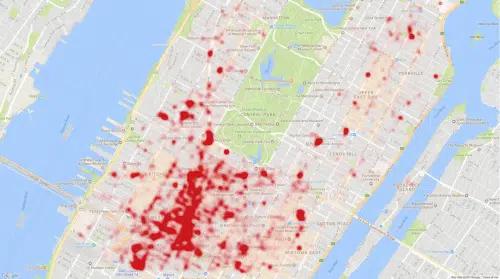Technion researchers have developed a technology to map the correlation (correlation) between a geographical place and the emotions it evokes

What is the connection between our geographical location and the feelings that arise in us? What places tend to make people happy and what places make them angry or sad? Now we have the answers thanks to a joint study by researchers in the Faculty of Civil and Environmental Engineering at the Technion and AT&T's research laboratories.
The research, which makes it possible to discover the correlation (correlation) between location and emotional state, was conducted as part of research student Ben Galon's doctoral studies under the guidance of Prof. Yarah Deutscher from the Technion and Dr. Yaron Kanza from AT&T. The three developed an algorithmic system to create an emotion map in an urban space, based on the analysis of social media messages such as tweets on Twitter.
So far, emotional maps have been based on monitoring volunteers using sensors that monitor heart rate, blood pressure, etc. This method severely limits the amount of information that can be collected. Now, thanks to the new approach, it is possible to produce maps based on vast amounts of information. The Technion researchers were able to associate an emotion with a location through syntactic analysis of messages containing location tags. The algorithm they developed makes it possible to locate clear connections between an emotion and a place and sift out the accidental connections.
The emotion map produced with the technology developed by the researchers shows the typical emotions expressed in different places. Maps of this type have a variety of possible uses - for example, they may help the tourist choose a place that is expected to evoke joy or romantic feelings and avoid places that instill anger and enmity. City planners will now be able to identify areas where the design evokes negative emotions and change them to evoke other emotions. Researchers in the social sciences will be able to learn about connections between the behavior of communities and their environment and identify, for example, areas that intensify artistic feelings or anger that may lead to political activism.


The study faced three main challenges. First, messages on social media are often short, sloppily written and contain phrases, abbreviations and slang, so it is difficult to accurately characterize their emotions. Second, everywhere a wide range of emotions is expressed, so it is important to filter out the sparse and random connections and leave only the significant and clear correlations. Third, to get significant results in a short time, a fast algorithm is needed that is able to deal with huge amounts of data.
The proposed method was tested on a database of tens of millions of messages created in New York City. Anger, for example, was detected at a high level in public transport stations. Sadness and anger - in high schools. Anxiety - on university campuses but also in Madame Tussaud's wax museum. Joy, sometimes accompanied by surprise - in restaurants and parks. All the emotions examined appeared with high frequency in theaters and movie theaters.
According to the doctoral student Ben Galon, the continuation of the research will focus on an in-depth analysis of the results, in order to understand the reasons for the links found between emotion and place, and on introducing the time dimension into the new emotion maps. The study was conducted in the USA partly due to the extensive use by Americans of networks such as Twitter, but the technology is relevant wherever these networks are widely used.
